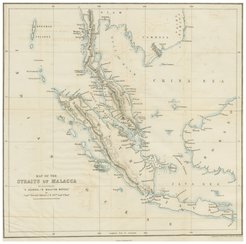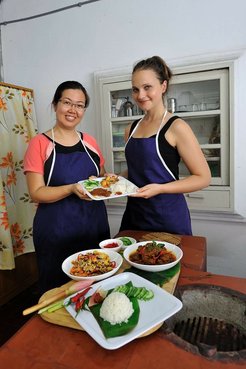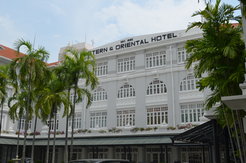Manifestations of Maritime Connections: Penang in the Indian Ocean World
As a macro-region, the Indian Ocean is considered one of the oldest and most important contact and trading zones in the world. While the Malay Archipelago has long been crucial for trading routes and networks across the Indian Ocean, its richness in sought-after spices was one of the major reasons for local, interregional and international trading rivalry in the region. In the seventeenth and eighteenth centuries, the Dutch held a virtual monopoly over the spice trade, much of which took place through Melaka, located on the Straits of the same name. In order to challenge this monopoly, the British East India Company founded George Town in 1786 on the small island Penang, located strategically at the northern end of the Straits of Melaka. Penang, with George Town as its main settlement, emerged as an alternative trading centre in the Straits under the British and soon overtook Melaka in importance. For a wide variety of reasons many people came to the island – which had the status of a free trading port and was elevated for a brief period as the fourth presidency of British India – and they stayed there to seek their livelihoods and fortunes. The peopling of Penang is therefore mainly a story of trade, exchange and connectivity.

Employing an ethno-historical perspective, my research and thesis explore the dynamics of Penang as a port city by analysing the manifestations of historical and spatial connectivities. I approach ports neither as something static and fixed, nor as the foundations for networks and movements across the Indian Ocean, but rather as a result of multifaceted connections and mobilities. I argue that travelling goods, people, ideas, religions and knowledge, as well as foods, tastes and eating habits, played a formative role in Penang’s past and present.
Focusing on hybrid cultures, in this case the Peranakan, I explain the manifestations of processes of maritime connectivity by examining the material and intangible heritage of these groups. Peranakan is the Malay term for locally born people of various origins, often described as the offspring of foreign traders and local women. The two groups I mostly engaged with during my twelve months of field research in 2015 and 2016 were the Jawi Peranakan and the Baba Nyonya. In terms of their material and intangible heritage and their narratives of origin, the Jawi Peranakan are a mixture of Indians or Arabs with Malays; the Baba Nyonya, by contrast, are considered to be the offspring of Chinese traders and local women who have resided in the Malay Archipelago for over five generations. Both groups emerged in port cities and are therefore valuable for an anthropological approach to port city dynamics, especially because they embody processes of maritime connectivity.

In order to analyse the connections that are discernible in Peranakan material culture, I decided to engage with the port city’s unique cuisines. Having received a professional introduction by chefs to the intricacies of some of the dishes, which are considered to be as old as the Peranakan groups themselves, I realised that they function as important identity markers. The ways in which food is prepared, performed, eaten and offered are strongly influenced by various cooking techniques, localities and histories. This influence can be traced in the routes that particular dishes took and the transformations they reveal. Approaches to the anthropology of food oscillate between discussions of cultural continuity, where terms like ‘traditional’ and ‘authentic’ play a role, and local transformation, which deals with the concepts of the assimilation, acculturation and creolisation of cuisines. Dishes can be seen as manifestations of connectivity processes, which are defined by changes in local and global settings, as well as by the movements of people, ingredients and techniques.
For over two centuries, Penang has been a place where new cultures have emerged and where Western cultures have exerted a significant influence by becoming part of a unique local heritage. Therefore, besides the local cuisine, issues of heritagisation and colonial nostalgia are also at the forefront of my research. Through mimetic strategies, some aspects of Western cultures have become intrinsic elements of Penang’s hybrid cultures. Through processes of (re-)composition they have created something original, different, enduring, and most of all their own. Since Malaysian independence the colonial heritage has been neglected in the narrative of national heritage as part of an attempt to strengthen an ‘authentic’ national identity. But to claim that a phenomenon like colonial nostalgia, as made visible, for example, in the E&O Hotel, is only an imitation of Western culture or a form of neocolonialism neglects the fact that a port city like George Town has always been a place of connectivity and exchange, as have other port cities in the Indian Ocean with similar geographical, historical and social backgrounds.

Thus, the aim of this thesis is to provide a deeper understanding of how a port city – in this case, Penang – comes into being by focusing on ethno-histories and manifestations of maritime connections; at the same time, the thesis also contributes to discussions of hybridity, acculturation, assimilation and transculturalism. Although the Peranakan of Penang have ancestral links to migrants, they are nevertheless quite different from diasporic communities. I contend that they are also not somewhere ‘in between’ but are rather manifestations of maritime connectivities and constitute something original and unique to this port city. The Peranakan’s points of reference are to the local port cities in the former Strait Settlements, yet their core material and intangible heritages were formed by the syncretic influences of maritime connections. Even though these particular groups might be unique to this port city, they are the outcome of prolonged intraregional networking and are representative of connectivity processes in general. Therefore, they offer insights into the dynamics of port cities, where the emergence of new groups of people and their tangible and intangible heritages become manifest through connectivity, mobility and interchange.


